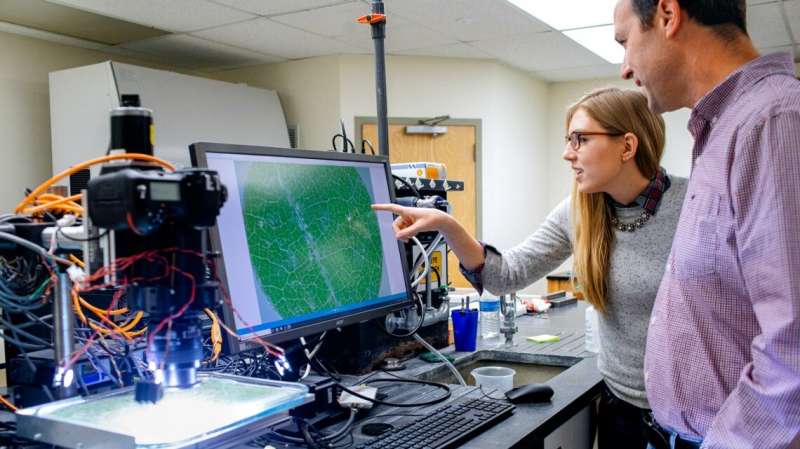USDA Agricultural Research Service scientists Anna Underhill, left, and Lance Cadle-Davidson at Cornell AgriTech analyze responses of a grape breeding line to powdery mildew, using data from an imaging robot. Credit: Allison Usavage/Cornell University
Transferring genetic markers in plant breeding is a challenge, but a team of grapevine breeders and scientists at Cornell University have come up with a powerful new method that improves fruit quality and acts as a key defense against pests and a changing climate.
Plant breeders are always striving to develop new varieties that satisfy growers, producers and consumers. To do this, breeders use genetic markers to bring desirable traits from wild species into their cultivated cousins.
The team's new technique for developing genetic markers improves markers' transfer rate across grapevine species from 2% to 92%. With it, breeders worldwide can screen their collections and find out immediately which vines have the traits they want—regardless of what varieties they are, where they came from or which species their parents were.
"This new marker development strategy goes well beyond grapes," said co-author Bruce Reisch, professor of horticulture in the College of Agriculture and Life Sciences, and leader of Cornell's Grapevine Breeding and Genetics Program. "It's applicable for breeding and genetic studies across different grape breeding programs, plant species and other diverse organisms."
To create the genetic markers, the research team used new automated DNA sequencing technology to create a "core genome" for grapevines, matching important regions shared between 10 species' genomes. Using powerful new genetic mapping technology, they targeted those regions to develop robust DNA markers.
This breakthrough in translating the grapevine genome into a common language for breeders is central to the mission of VitisGen2, the second iteration of a multi-institution research project from which the new marker development strategy emerged.
"This is game-changing work—and it's only the beginning," said Donnell Brown, president of the National Grape Research Alliance, an industry-led nonprofit representing the research interests of wine, juice, raisin and table grapes. "From here, we can greatly accelerate the genetic exploration that will help us improve fruit and production quality and, ultimately, respond to the threats of pests and diseases, a changing climate and more."
More information: Cheng Zou et al, Haplotyping the Vitis collinear core genome with rhAmpSeq improves marker transferability in a diverse genus, Nature Communications (2020). DOI: 10.1038/s41467-019-14280-1
Journal information: Nature Communications
Provided by Cornell University
























